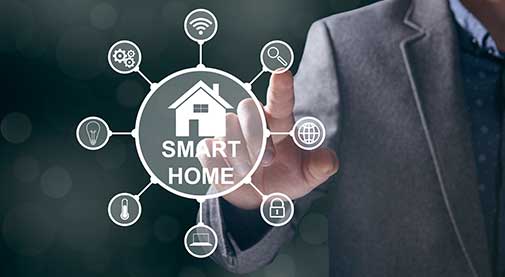As AI continues to expand automation’s capabilities, such as replicating human decision-making and anticipating human behavior, it offers huge benefits in terms of convenience and smart support.
AI in Smart Homes
The application of AI in managing the smart home infrastructure helps gather data from the home automation devices, anticipate user behavior, give maintenance data, and aid better data security and privacy. Because of its ability to do certain activities automatically for the user, its presence in home automation enables us to control our home appliances, safeguard our houses, and so on by reducing the need for human intervention.
This automation relies heavily on the data acquired by the devices and trained on utilizing a range of machine learning and deep learning methods. Smart home-linked devices provide the data, and the AI learns from the data to do particular activities without human interaction.
For example, Teksun thermostats learn automatically from their customers’ behavior on how to operate and then utilize that information to adjust the temperatures when someone is home or go energy efficient when no one is home.
The Internet of Things in Smart Homes
IoT allows connected devices, vehicles, buildings, and other items implanted with software, sensors, and the internet to communicate with one another and may either be operated remotely or relay data to a distant user via AI. With the help of AI, these linked devices can monitor the status of every device connected to the same network and offer real-time data.
Important Considerations for Any Smart Home System

1. Data security and privacy are the two most important issues that any AI and IoT-enabled smart home should solve. Every connected device leaves digital traces of personal data that must be kept safe and secure.
2. Proper AI and IoT integration enables devices to perform more automatically and with expanded features. Security cameras, for example, often warn of threats automatically, but with correct AI integration, they will proactively alert humans to take charge of the situation when something goes wrong.
3. Interoperability is a critical issue that must be addressed by any home automation tool. Smart home devices should be made interoperable so that new use cases such as energy saving, appliance diagnostics, disaster damage prevention, and so on can be applied to the same smart devices.
4. Better customer service is an essential component of any organization. People living in smart homes may face issues inside their IoT environment, ranging from minor troubleshooting to major data protection concerns. Companies that deliver superior customer service will always be ahead of the competition.
5. Incorporating voice commands will allow the user to save time, and money and alleviate certain laborious activities. Voice control of devices and home appliances should be prioritized because providing user-friendly services always benefits the business.
How will the convergence of AI and IoT affect smart homes?
AI in smart homes can translate raw sensor data from connected smart devices into beneficial behavior designs in our daily lives. AI-enabled gadgets understand the patterns of the renters and forecast the best experience. It will not turn on the heating, fan, or lights if there is no one in the house, and it will automatically lock the doors if there is no one in the house.
A perfect scenario would be for a user to prepare meals in a smart oven or stove while AI checks the meal’s internal temperature. If the meal reaches the ideal temperature, the AI can lower the cooking temperature to prevent it from burning. The AI would notify the user when the meal was ready to be taken from the oven or burner.
Artificial intelligence (AI) may be able to learn and anticipate a user’s desires. For example, a smart kitchen may be set up before a client user reaches home to begin cooking.
The promise of IoT and AI isn’t restricted to new homes; there are a variety of options that allow current devices, such as switches, to be converted to Smart Switches and old air conditioners to be updated to provide remote access via Smart Apps or AI-based on cloud servers, among other things.
Wireless solutions facilitate deployment, requiring no major electrical or common labor to get the user to Smart Living. Almost any present switch, air conditioner, or light can be converted to IoT-enabled via various brand-agnostic retrofit methods.
The combination of AI and IoT in the smart home is a winning combo for tech-savvy households. AI-enabled personalization, rather than historical usage, can assist your home in keeping track of how you go about your everyday routine. AI and smart home automation have come to a crossroads. Significant gains will be realized as technology progresses and more device integration becomes available.
In Nutshell
Technology is changing and combining Smart Home requirements on a large scale. As the number of connected devices outnumbers humans, the concept of a smarter, more convenient home is gaining traction. Home automation has virtually endless applications.
Smart Homes, which blend AI and IoT, appeal to the technologically savvy while cutting energy expenditures and enhancing security. As a result, smart homes enable and safeguard the next level of technological existence.
The Internet of Things (IoT) and artificial intelligence (AI) are here to stay and will dramatically improve Smart Home automation.



